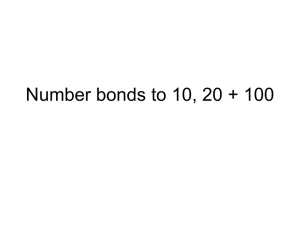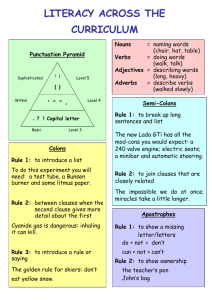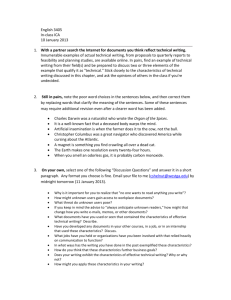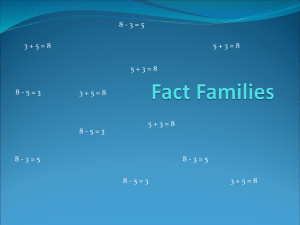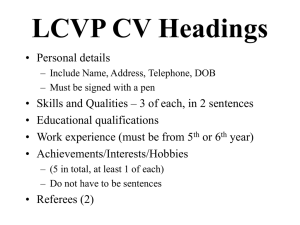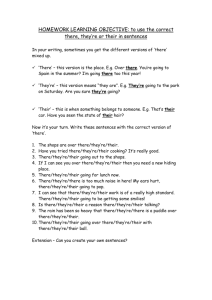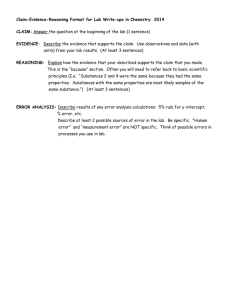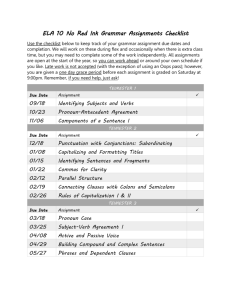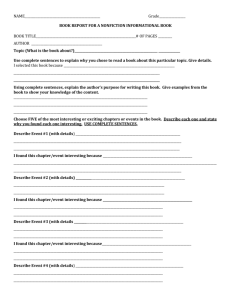1.29 Sentences - Birmingham City University. Library and
advertisement
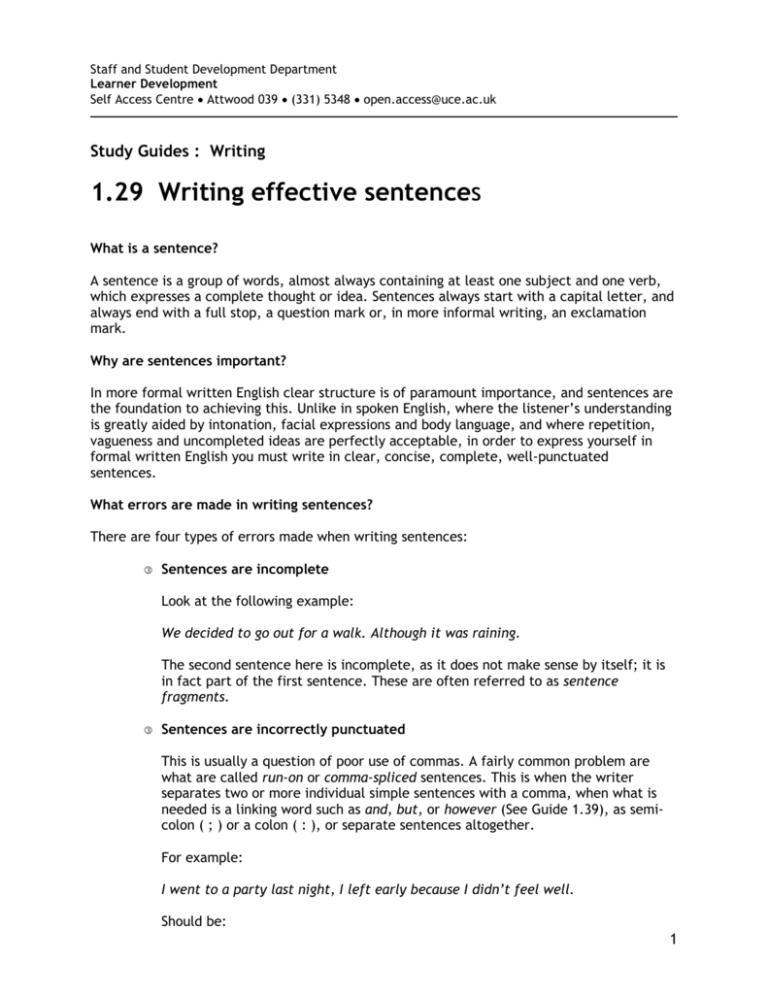
Staff and Student Development Department Learner Development Self Access Centre Attwood 039 (331) 5348 open.access@uce.ac.uk Study Guides : Writing 1.29 Writing effective sentences What is a sentence? A sentence is a group of words, almost always containing at least one subject and one verb, which expresses a complete thought or idea. Sentences always start with a capital letter, and always end with a full stop, a question mark or, in more informal writing, an exclamation mark. Why are sentences important? In more formal written English clear structure is of paramount importance, and sentences are the foundation to achieving this. Unlike in spoken English, where the listener’s understanding is greatly aided by intonation, facial expressions and body language, and where repetition, vagueness and uncompleted ideas are perfectly acceptable, in order to express yourself in formal written English you must write in clear, concise, complete, well-punctuated sentences. What errors are made in writing sentences? There are four types of errors made when writing sentences: Sentences are incomplete Look at the following example: We decided to go out for a walk. Although it was raining. The second sentence here is incomplete, as it does not make sense by itself; it is in fact part of the first sentence. These are often referred to as sentence fragments. Sentences are incorrectly punctuated This is usually a question of poor use of commas. A fairly common problem are what are called run-on or comma-spliced sentences. This is when the writer separates two or more individual simple sentences with a comma, when what is needed is a linking word such as and, but, or however (See Guide 1.39), as semicolon ( ; ) or a colon ( : ), or separate sentences altogether. For example: I went to a party last night, I left early because I didn’t feel well. Should be: 1 I went to a party last night but left early because I didn’t feel well. Alternatively, commas may not be used at all, or used in the wrong place. Sentences are too long The longer your sentence, the more control you need over punctuation, linking words, and use of pronouns. If you use any of these badly, then your reader will become confused. The last thing you want is for your tutor, getting through a pile of 50 essays at midnight, to have to start reading a sentence three or four times to try and make sense of it. It is therefore usually recommended that you write in fairly short sentences, maybe a maximum of around 20-25 words or a couple of lines. As you get more practice and your writing improves, you can start to make your sentences longer. Sentences are too short Don’t go to the opposite extreme and write lots of very short sentences of just a few words. Your writing will become “bitty”, and again will become tiring for the reader. Occasional short sentences can be very effective to emphasise a point, but don’t put lots of them together. There is more detail on these four points later in this guide. Types of sentences Sentences are made up of clauses. A clause is a group of grammatically-related words including a verb and a subject (though sometimes is the subject is implied). Clauses are the building blocks of sentences: every sentence consists of one or more clauses. In more complex sentences there is always a main clause, together with one or more relative or subordinate clauses. And getting even more technical, clauses can be finite or non-finite. Finite clauses are based on verbs which indicate tense, such as “saw” or “will go”, whereas non-finite clauses are based on infinitives (the base form of the verb, such as “consider”) or participles (for example, “taking”). Simple sentences Simple sentences contain just one finite clause and express just one idea or provide just one piece of information. They can be very short: I passed the test. Or much longer: Living only 3km away from the University on a main bus route, he was able to get to his lecture in just 15 minutes. In this second example, 24 words long, the first clause is non-finite (living), while the second is finite (was able to). Although a longer sentence, it still just expresses one piece of information. 2 Compound sentences These sentences contain two or more simple sentences, or independent clauses, joined by conjunctions such as or, but or and or by a semi-colon or a colon. They can have one subject and two verbs: UCE is a modern university and is spread over several campuses. Birmingham is the second biggest city in the UK; it is situated in the centre of the country. Or two subjects (or a repeated subject) and two verbs: I decided to have a gap year before starting my degree course, but most of my friends went straight to university. It was the best concert I had ever been to: Tom Waits sang magnificently. Remember not to separate the two parts of these sentences with just a comma. Complex sentences Complex sentences consist of two or more clauses, but unlike compound sentences in which the clauses are “equal” and can be independent, in this type of sentence they are not equal; there is a main clause, a simple sentence which can be independent, with other clauses dependent or subordinate on it. These clauses do not make complete sense by themselves and are joined to the main clause by linking words or phrases such as the conjunctions although, because, when, if etc. They have one finite verb and their function is to give reasons, conditions, concessions, times of action etc. An example: If England keep on playing in the same manner, they won’t win the World Cup. Here, the first clause (If England ...), although the longer of the two, is dependent on the second clause, which is the main one. If England keep on playing in the same manner doesn’t make complete sense by itself, whereas they won’t win the World Cup does. The second part, therefore, is clearly the more important piece of information, while the first part is just one of the conditions, or in this cases reasons, for saying this. Other examples: Although the workers have been given a 7% pay rise, they are still not happy with their situation. We left for the airport two hours earlier than usual because the baggage handlers were threatening strike action. Your aim should be to use a variety of sentences in your writing: Short simple sentences grab the reader’s attention and add emphasis. Compound sentences can emphasise balance and parallel ideas. Complex sentences show what information depends on what other information. 3 Avoiding sentence fragments Sentence fragments usually occur when a sentence is prematurely brought to an end and a new sentence unnecessarily started. This new sentence very often begins with a conjunction such as although, if, however, but etc. and is in fact a dependent clause which needs the other part of the sentence to make sense. Complex sentences can often be written “the other way round”: If I win the lottery, I’m going to retire. means more or less the same as I’m going to retire if I win the lottery. The only difference is one of emphasis (and a comma in the first version). A reason some people write sentence fragments, therefore, may be that they think conjunctions always come at the beginning of a sentence. This is not true. Sentence fragments also occur when a non-finite clause is made into a simple sentence. For example, Considering the complexities of the application procedure. is not a sentence. The participle considering by itself does not indicate tense; we do not know if the writer is referring to the past, present or future. This non-finite clause needs an additional finite clause in order to make sense: Considering the complexities of the application procedure, it is surprising how many people do apply for a loan. Here are some more examples of sentence fragments; try and rewrite them as complete sentences. 1 A franchiser can achieve wide distribution. As each franchisee has to buy stock from the franchiser. 2 In order to succeed in business internationally. The manufacturer must find out about local markets. 3 Minimum wages could help to increase income because if wages are low, production will be high and cost prices will be reduced. Resulting in an increase in the company's income. 4 If everyone earns the same amount of money. At the end of the day, whether you have skills or not, the wages will be the same. 5 Settings should be made at 15.8 – 16.2 cm. Allowing for natural variations and differing local conditions. 6 When the first UK McDonald's opened in 1974 in London. A totally new eating experience arrived in this country. 7 First of all. The general socio-economic climate in the UK encourages small businesses. 8 Due to the increase in payment by card. Mondex stands a good chance of being widely accepted. 4 9 If the trademark and location are both very attractive. There will be a lot of replies. 10 Starting with the first example. It has been shown that extensive revision does not always lead to success. 11 According to Walsh (1990), the number of employees in part time employment increased from 15% in 1971 to 30% by the mid-1990s. While findings by the Institute of Manpower Studies (1985) found the proportion of women part-timers grew from 38% to 46% between 1974 and 1985. 12 The core group of the company comprises senior employees who possess particular skills. Such as marketing managers, sales staff, IT experts and distribution management. Avoiding run-on/comma-spliced sentences Sentences of this type have at least two parts, either one of which can stand by itself (in other words, two independent clauses), but the two parts have been merged together instead of being properly connected. The length of a sentence has nothing to do with whether a sentence is a run-on or not; being a run-on is a structural flaw that can plague even a very short sentence: It’s raining, take you umbrella. An extremely long sentence, on the other hand, might contain a lot of waffle, but it can still be otherwise sound structurally. When you use a comma to connect two independent clauses, it must be accompanied by a conjunction (and, but, for, nor, yet, or, so). It’s raining, so take your umbrella. Run-on sentences happen typically under the following circumstances: a. When an independent clause gives an order or directive based on what was said in the prior independent clause: This next chapter has a lot of difficult information in it, you should start studying right away. (We could put a full stop where that comma is and start a new sentence. A semicolon might also work there.) b. When two independent clauses are connected by a transitional expression (conjunctive adverb) such as however, moreover, nevertheless. Mr. McGrath has sent his four children to independent schools, however, he has sacrificed his health working day and night in his factory. (Again, where that first comma appears, we could have used either a full stop — and started a new sentence — or a semicolon.) 5 c. When the second of two independent clauses contains a pronoun that connects it to the first independent clause. This computer doesn't make sense to me, it came without a manual. (Although these two clauses are quite brief, and the ideas are closely related, this is a run-on sentence. We need a full stop where that comma now stands.) Most of those computers in the Learning Centre are broken already, this proves my point about British computer manufacturers. Again, two nicely related clauses, incorrectly connected — a run-on. Use a full stop to cure this sentence. Adapted in part from: http://webster.commnet.edu/grammar/runons.htm Practice exercise The following sentences are all run-ons. Try to devise two different ways to correct each one. 1. The co-op board voted to fine the tenant for noisiness, it is not clear whether he violated any established rule. 2. Tom was always late for his legal seminar he knew it annoyed the professor and would affect his grade but he just couldn’t get up on time. 3. The defendant will argue that she had no knowledge that the merchandise was stolen however, the evidence indicates otherwise. 4. The mortgage company refused to issue a refund check for excess funds in the Smiths’ escrow account, this violated the law. 5. The textbook gives many examples of run-on sentences, there is no answer key, how can we check our answers? Exercise source: http://www.law.cuny.edu/wc/usage/run_on_sentences.html Steve Gould 2003 steve.gould@uce.ac.uk Related Learner Development Study Guides: 1.35 1.36 1.38 1.39 Writing effective paragraphs Punctuation Word order Cohesion: linking words and phrases Further guidance on the writing sentences can be found here: webster.commnet.edu/grammar/sentences.htm www2.ncsu.edu/ncsu/grammar/Syntax3.html 6
